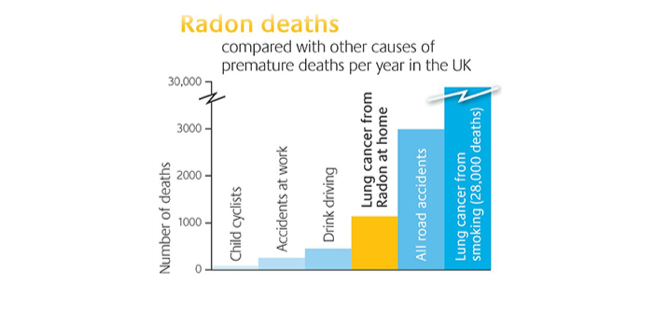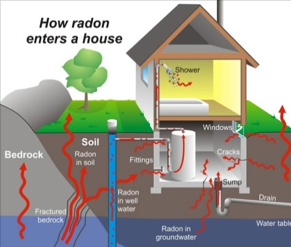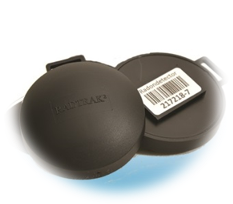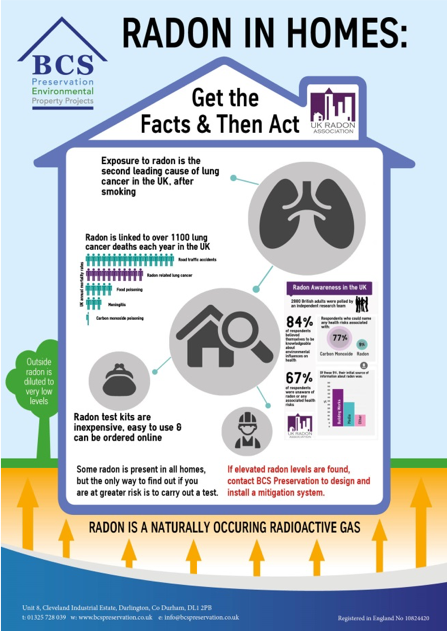Enter your details below and we will call you back as soon as possible:
UK Radon Awareness Week!
This week the UK Radon Association is running its annual UK Radon Awareness week in partnership with Public Health England (PHE) and BRE Academy, the primary goal being to raise the public’s awareness of radon. The theme for the 2018 campaign is Healthy Living and takes place from 5th to 11th of November 2018.
The campaign sees employers, home owners and health care professionals gain a greater knowledge of the naturally occurring, radioactive gas and the dangerous effects it can have on the human body. Radon is the second leading cause of lung cancer, and an increased awareness of Radon will lead to a reduction in the number of avoidable lung cancer cases claiming lives each year.
So, what is Radon?
Radon is a naturally occurring colourless, odourless, radioactive gas that can affect properties of all types, ages, locations and uses. It is formed by the radioactive decay of the small amounts of Uranium that occur naturally in all rocks and soils.
Radon levels in the air that we breathe outside are very low, but the levels indoors can become much higher. When the Uranium in the soil and rocks decay, the Radon formed permeates the ground into the open air. It is quickly diluted to low concentrations, however, if it rises into a building, it can become trapped and build to dangerous levels.

What are the risks of Radon exposure?
When the concentration of Radon gas is high, tiny radioactive particles are inhaled and some are deposited in the lungs. The radiation from these particles damage the lung tissue, and over a long period of exposure may cause lung cancer.
The risks are particularly higher for smokers and ex-smokers.
Official statistics estimate that over 1100 people in the UK die every year from lung disease as a result of radon exposure.
In what area is Radon most commonly found?
Although certain parts of the country are believed to be at a greater risk from Radon due to the underlying geology and varying amounts of Uranium present, any property in any location can contain elevated levels. The latest set of indicative maps published by Public Health England (PHE) show that Radon can be found nationwide, UK Radon Map

But how does Radon enter a building?
The air pressure within a building is usually lower than the pressure in the soil and rocks around the building’s foundation. Radon enters the building through a process referred to as advection. This is where the gas moves from a point of higher pressure (the ground, soil and rocks) to a point of lower pressure (the building). The difference in pressure causes the building to act as a vacuum, drawing Radon in through foundation cracks and other openings. It is at this point that the Radon becomes trapped within the building and where the levels can start to build up.
I’m worried about the Radon Levels in my property – What can I Do?
The only way to know whether elevated levels of Radon are present is to place a detector in the property for a period of time. In a standard domestic property, one detector will be used in the ground floor living room and one in a first floor bedroom. In a commercial property, the number of detectors required generally depends upon the size, layout and use of the building.
The detectors are then analysed in a laboratory to determine the level of radiation they were exposed to and a written report detailing the results will be provided.

If elevated levels of Radon gas are detected, we are one of the country’s most experience contractors in Radon remediation. Our specialist surveyors will design a system based upon the severity of the problem and the type of construction.
To prevent Radon from entering the property, a specially calibrated fan can be installed to reverse the pressure differential between the ground, soil and rocks and the inside of the property. Alternatively, a sump can be created beneath the building to become a lower point of pressure.
Once any remedial works have been carried out, BCS will always supply a set of radon detectors so testing can be repeated to confirm that the concentration has fallen to an acceptable level.

Radon in the workplace!
All employers are legally obliged to assess any risks to their staff while at work and this should include potential radon exposure.
In workplaces such as offices, where hazards are generally pretty low, Radon exposure can be the largest occupational health risk.
PHE recommends a five point plan for employers with premises in a Radon Affected Area:
- Measurement – Test for Radon on the ground floor and occupied basements.
- Surveillance – Continue monitoring until remedial action is complete.
- Risk Assessment – Set priorities for action based on Radon levels.
- Mitigation – Complete remedial action within six months.
- Maintenance – Conduct periodic testing and routine checks.
BCS Property Projects provide specialist radon testing and mitigation services throughout the entire UK. With our specialist surveyors on hand to help, don’t leave it to chance. If you discover that your building is in a risk area or you just want some advice contact us on 01325 728039 or email info@bcspreservation.co.uk






















